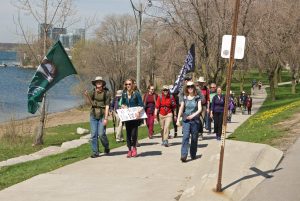Spirited Reflection: Pilgrimage for Indigenous Rights

But this is the covenant that I will make with the house of Israel after those days, says the Lord: I will put my law within them, and I will write it on their hearts; and I will be their God, and they shall be my people. – Jer. 31: 33
Photo by Murray Lumley: The Pilgrimage for Indigenous Rights walking through Toronto on April 27, 2017.
Earlier this month, I joined a group walking from Kitchener-Waterloo to Ottawa, called the Pilgrimage for Indigenous Rights. Organized by Mennonite Church Canada and Christian Peacemaker Teams, the pilgrimage had two primary goals:
- to visit churches to foster conversations about the United Nations Declaration of the Rights of Indigenous Peoples (UNDRIP) and its role as a framework for reconciliation and
- to call on the Canadian government to fulfill its promise to implement UNDRIP.
In particular, we walked in support of Bill C-262, a private member’s bill by MP Romeo Saganash that provides a legislative framework for UNDRIP’s implementation. (KAIROS has published an excellent action resource as well as educational materials on UNDRIP and Bill C-262 available on its website.)
The most common question we were asked, by our church hosts, by reporters, and others, was simply, “Why?” Walking 600 km is not something normal in our society. If I’m truly honest, part of my answer is that the pilgrimage was exciting. We had the opportunity to walk alongside and learn from Indigenous leaders including Romeo Saganash, Leah Gazan, Myeengun Henry, James Bartleman, and Sylvia McAdam. We were welcomed by Shabot Obaadjiwan First Nation, whose Chief Doreen Davis sat with us for hours sharing heart-stopping stories of her community’s successful resistance to uranium mining and military tests on their land. We arrived in Ottawa to the sound of church bells and applause, and marched through the streets near Parliament. We were photographed, filmed, and interviewed.
Yet I also vividly remember the physicality of the pilgrimage: aching feet, legs, and back, taped-up toes. Murmured prayers and meditations repeated over and over in pace with my steps. The almost imperceptible daily shifts from enthusiasm to exhaustion to a second rush of adrenaline. The delicious relief of stretches and of back rubs from friends, and the joy of singing together in harmony.
All this was also an essential part of our journey. The walking was humbling, painful, joyful. I was reminded that we were walking in the footsteps of hundreds of Indigenous youth and water walkers, who for decades have been walking for justice. I learned that I could not rely only on my own strength to keep going, but that I needed 87-year-old Henry Neufeldt’s steady pace, 11-month-old Junia Boos’ radiant smiles, and 11-year-old Abby Heinrichs’ courageous words. I learned that justice is slow and hard.
I also began to write the words of UNDRIP on my mind and heart: a covenant we have made with the Indigenous peoples on whose lands we live. Each of the long-term walkers memorized one or two articles of the Declaration. I learned Article 28, like so much else in the Declaration, simple yet deeply challenging:
- Indigenous peoples have the right to redress, by means that can include restitution or, when this is not possible, just, fair and equitable compensation, for the lands, territories and resources which they have traditionally owned or otherwise occupied or used, and which have been confiscated, taken, occupied, used or damaged without their free, prior and informed consent.
- Unless freely agreed upon by the peoples concerned, compensation shall take the form of lands, territories and resources of equal quality, size and legal status or of monetary compensation or other appropriate redress.
Walking along the shoulder of Highway 7 for ten days, past forests, fields, rivers, houses, strip malls, shuttered stores, and far too much windblown garbage, I could see that what settler society has done to this land cannot be undone. We can pick up the trash, plant trees, free rivers from concrete embankments, but there are scars that will not disappear. We cannot undo colonization. We can, and should, return some of what has been taken, yet we are still here, settlers who call this place home. We don’t fully know what is needed to make things right. Seeking to walk with Indigenous peoples, we are working for a justice that is beyond our vision, that we will only discover in conversation, over generations.
May the Creator open our hearts to listen, and to act when we are called upon.
Esther Townshend is Toronto coordinator of the Student Christian Movement, a youth- and student-led grassroots, ecumenical network for social justice, community in diversity, and radical faith in action. Living in Toronto’s Parkdale neighbourhood, she also enjoys writing, singing, cycling, and lively kitchen table conversations.








